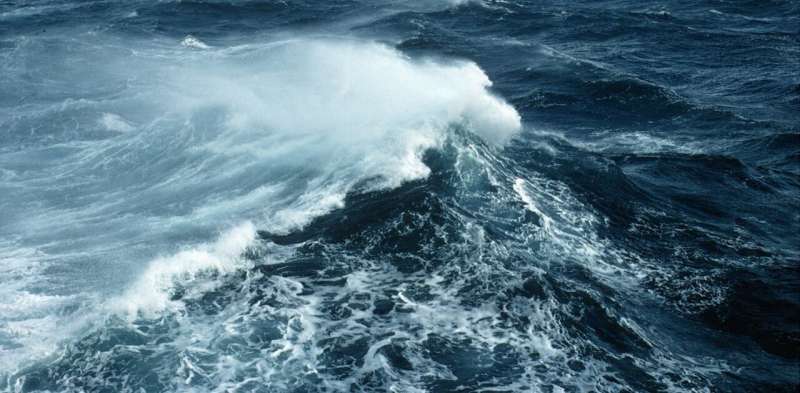This article has been reviewed according to Science X's editorial process and policies. Editors have highlighted the following attributes while ensuring the content's credibility:
fact-checked
trusted source
written by researcher(s)
proofread
Giant waves, monster winds and Earth's strongest current: Why the Southern Ocean is a global engine room

The Southern Ocean is wild and dynamic. It experiences Earth's strongest winds and largest waves. It is home to city-sized icebergs and the biggest ocean current on the globe, as well as tiny turbulent flows that fit inside a teacup.
The Southern Ocean is also crucial to Earth's natural systems. It forms the dense water that fills the world's deep oceans. It stores heat and carbon resulting from human-caused global warming, and controls the flux of heat to the huge ice sheet of Antarctica—the greatest threat to runaway global sea-level rise.
The scale and complexity of the Southern Ocean can be hard to comprehend. But our new paper may help. It summarizes the present state of understanding of the Southern Ocean, how it is changing, and where the knowledge gaps lie.
Scientists and others regularly voyage to the Southern Ocean's furthermost icy reaches—but more research is needed. The scientific and broader community must join together to advance Southern Ocean science and protect this vital natural asset.
Masses of ice at risk
The Antarctic Ice Sheet is the largest ice mass on Earth, equivalent to 58 meters of the global sea level.
The ice sheet flows onto the Southern Ocean surface in the form of giant ice shelves. Many of these ice shelves are being eaten away from below by a warmer ocean, or crumbling and becoming icebergs at a faster rate than before.
Beyond the ice shelves, millions of square kilometers of the Southern Ocean surface is frozen into a layer of sea ice. This acts as a giant solar reflector and shields ice shelves from powerful Southern Ocean waves.
After decades of seemingly defying warming temperatures, the Southern Ocean's sea ice has dramatically declined in recent years. This puts ice shelves and the ice sheet under even greater stress.
Filling Earth's oceans
Much of the sea ice is produced in small regions of open water, called "polynyas," formed by strong and cold winds blowing off Antarctica. These winds cool the ocean surface below the freezing point, causing ice to form.
As the ice forms, it ejects salt into the ocean surface. This extra salt, in addition to cooling effects from the atmosphere, makes the surface seawater heavier, or more "dense."
The dense water sinks in turbulent plumes (imagine an upside-down volcano) and cascades through underwater canyons into the deep ocean, while mixing with overlying waters.
The resulting dense water mass, produced in only a few relatively small regions of Antarctica, accounts for an extraordinary 40% of the global ocean volume. It is ultimately lifted back to the ocean surface by centimeter-scale turbulent eddies—of the type you see when mixing milk into your tea.
In the deep ocean, this mixing is largely driven by ocean tides that slosh over the rough seafloor and produce internal waves.
Climate system at risk
It takes many hundreds of years for the ocean water to cycle from the surface Southern Ocean to the deep and back. Water returning to the surface today is like a time capsule, reflecting the cooler, pre-industrial climate when it first sank to the ocean depths.
The water that sinks today has absorbed more carbon to store in the deep ocean, helping to limit global warming.
However, models and observations suggest reductions in sea ice and ice shelves are weakening this crucial climate system. They are making the water warmer, less salty and more buoyant, so less prone to sinking. This means less carbon storage and a warmer atmosphere in the years ahead.
So much we don't know
Making measurements in the Southern Ocean is immensely challenging due to its remote location and hostile conditions. This means in many cases data is sparse, and so scientists don't know exactly how quickly changes are occurring.
Our review identified several areas as a key priority for future Southern Ocean research. They include observations of ocean temperatures and melting beneath ice shelves, as well as long term measurements of dense water formation.
More data is needed to monitor changes and provide early warning of significant climate events, such as ice sheet collapse. Crucially, more data is also needed to inform and assess the computer models on which government, industry and society rely to predict future climate.
Unfortunately, ocean observations are expensive. For example, Australia's premier research vessel, the RV Investigator, costs more than A$100,000 a day to run. And the new SWOT satellite—a joint project of the European Union and United States to measure the ocean surface at unprecedented resolution—cost more than US$1 billion.
These costs also highlight the need for enhanced national and international collaboration. This would make the best use of available resources, and promote technological innovation to develop more cost-effective observing systems such as drones and drifting robotic instruments.
The federal government's scientific priorities and funding decisions should reflect the crucial importance of Southern Ocean science.
We are currently in the UN Decade of Ocean Science, which aims to improve predictions of ocean and climate change. Improved understanding of the Southern Ocean is vital to this effort.
Provided by The Conversation
This article is republished from The Conversation under a Creative Commons license. Read the original article.![]()





















